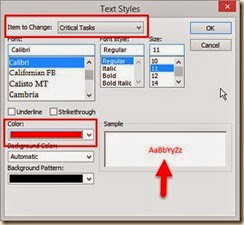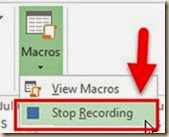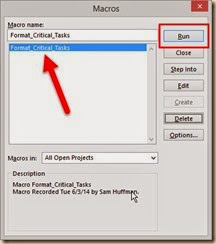This blog entry will walk you through the steps of recording a reusable Macro that formats Critical Gantt bars and task descriptions red. After running the Macro all current and future critical tasks will be immediately identifiable!
Here is what it will look like (Click on figure to enlarge):

Please note that I am using Project Professional 2013 in this example, though the same general steps may be followed in Project Professional 2010.
If you use Project in an enterprise environment or use Project Server, check with your administrative staff prior to creating and using this Macro.
Here are the steps:
A. Start recording the Macro:
1. Select the “View” tab.
2. Select the “Macros” button in the “Macros” group.
3. Choose “Record Macro…” from the drop down list.
Use the figure below to find the selection locations. (Click on figure to enlarge.)

4. Give the Macro a name:
The “Record Macro” dialog is presented for your entry of its Name and Shortcut key if you desire one. I named this example “Format_Critical_Tasks” so that I know what it does. (See figure below for details.)

Once you click on “OK” the Macro begins to record.
B. Format the Gantt Bars:
1. Select the “Format” tab.
2. In the “Bar Styles” group, check the “Critical Tasks” check box.
Use the figure below to find the selection locations. (Click on figure to enlarge.)

C. Format Critical Path Text:
1. Select the “Format” tab and select “Text Styles” from the “Format” group.
2. This will bring up the “Text Styles” dialog. Make these entries:
a. Click in “Item to change:” and choose “Critical Tasks” from the drop down list.
b. Click in “Color:” and choose red.
c. Click on “OK” to apply your changes.
Use the figure below to find the selection locations. (Click on figure to enlarge.)

The reward for your actions is that the Critical Path tasks are now literally popping from the page! It should now correlate the Critical Bars and Text so that they are obvious. See figure below. (Click on figure to enlarge.)

D. Stop the Macro
1. Select the “View” tab.
Select the “Macros” button from the “ Macros” group.
3. Choose “Stop Macro” from the drop down list. Use the figure below to find the selection locations. (Click on figure to enlarge.)

The Macro can now be run on any file by returning to the Macro list, choosing the Macro and clicking on the Run button as shown below.

There you have it –a reusable Macro identifying the Critical Path! As the data in your project changes, the formatting will change to reflect the new Critical Path.
My next blog entry will help you take your Macro to the next level – Assigning it to a button! Stay tuned…
If you enjoyed this blog entry, please let me know. If it was informative – then consider training! My training offerings can be found HERE.

